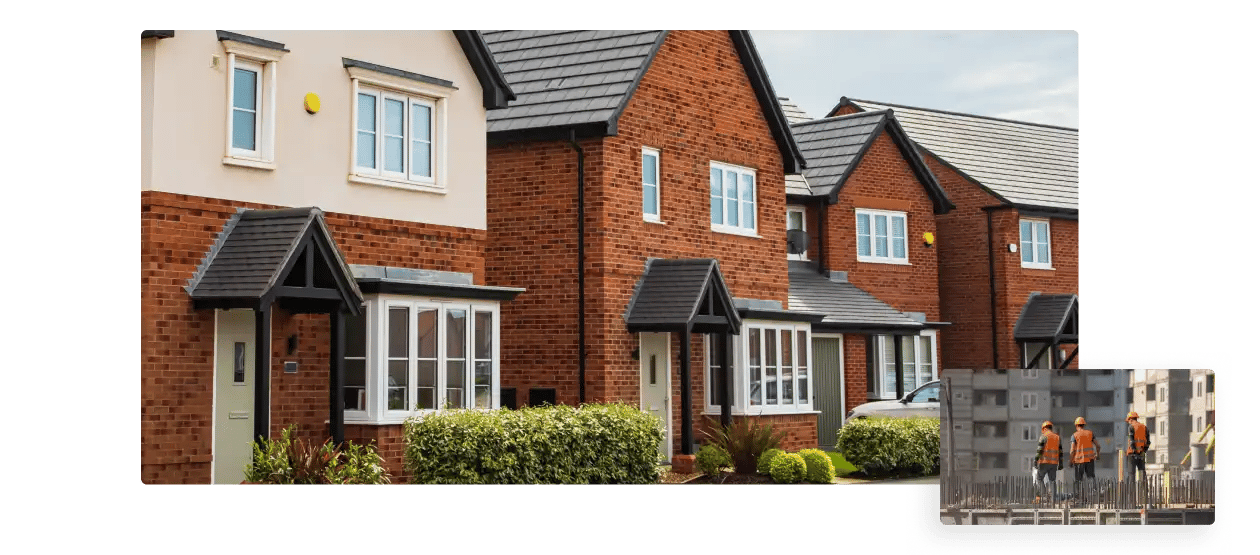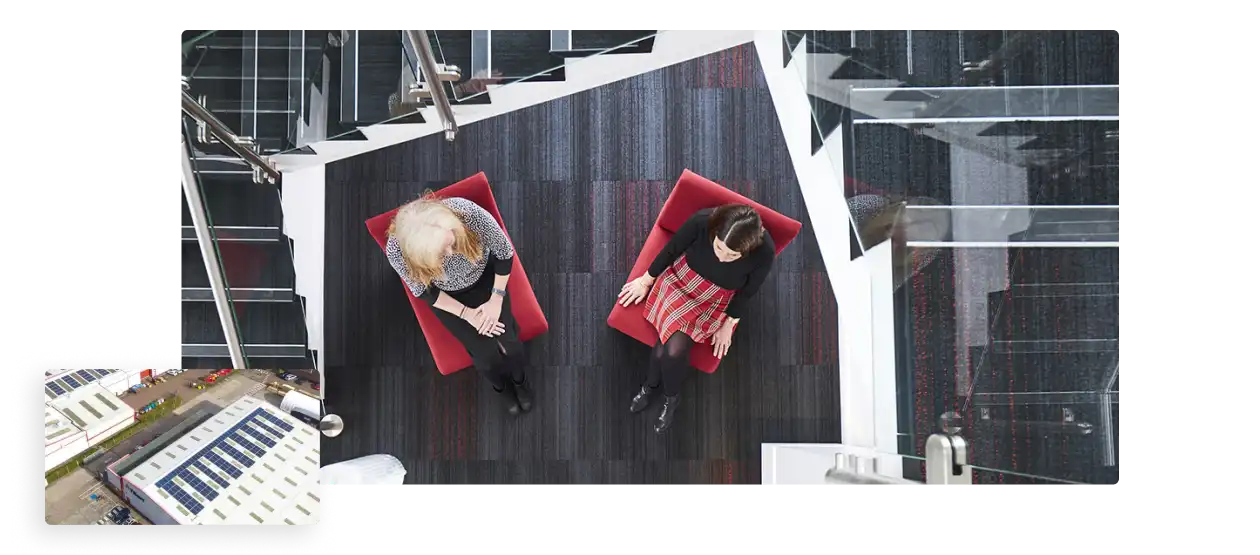Fire Safety First
Meeting Enhanced UK Building Regulations with
Titon’s Compliant-by-Design FireSafe® Range
TABLE OF CONTENTS
Meeting Enhanced UK Building Regulations with the Titon FireSafe® Range
Table of Contents
- Introduction
- Chapter 1: Key Legislative and Regulatory Drivers
- A Timeline of Key Reforms
- Chapter 2: Implications for Architects and Building Designers
- Chapter 3: The Challenge of Fire-Resistant Ventilation
- Chapter 4: Fire Compliance by Design: Titon’s FireSafe® Product Range
- Chapter 5: Design and Specification Guidance for Architects
- Chapter 6: Differentiation in the Market: Why Quality Matters
- Chapter 7: Titon's End-to-End Support
- Conclusion: Building with confidence
Introduction
A Paradigm Shift in UK Building Safety
The tragic events of the Grenfell Tower fire in 2017 shook the foundations of the UK’s building safety framework. A catastrophic failure in fire safety, Grenfell exposed long-standing gaps in product accountability and forced every professional involved in the built environment to confront a simple truth: the smallest component can pose the greatest risk.
Since the tragedy, fire safety has shifted from a specialist concern to a universal priority for UK construction. The industry is now undergoing transformative regulatory reform to prioritise human safety, product accountability, and fire resilience.
With the release of the Construction Products Reform Green Paper, and as the Building Safety Act tightens its grip and successive amendments to Approved Document B strip away the last loopholes, building professionals are under growing pressure to select materials that are compliant today and future-proofed for tomorrow’s more stringent standards.
Fire safety is no longer a box to be ticked; it is a design imperative that must be addressed from the earliest project stages. This culture shift demands a more proactive and accountable approach to ventilation from architects, designers, specifiers, and construction professionals.
Titon’s answer is the Titon FireSafe® range. Market-leading and complaint-by-design, each vent, air brick, and wall kit was conceived in the immediate aftermath of Grenfell and refined through years of testing, consultation, and redesign. The result is an award-winning family of ventilation products that marry airflow, durability, and a verified fire classification, offering architects and designers a reliable pathway to compliance and enhanced building safety right from the initial design phase.
This white paper provides architects and building designers with a clear overview of current regulatory shifts. It illuminates emerging responsibilities and requirements under the new regime and showcases how the Titon FireSafe® Range uniquely responds to these challenges.
Its purpose is to guide architects, designers, and specifiers towards compliant, fire-safe ventilation solutions and demonstrate how Titon supports the industry in building a safer future.
Part 1: The Evolving UK Fire Safety Regulatory Landscape
CHAPTER 1
Key Legislative and Regulatory Drivers
Regulation often evolves in cautious steps, yet the past five years have felt like a sprint.
The combustible cladding ban of 2018 drew a red line around materials in external walls, stating that if a component punctures an external wall, non-combustible is the default, not a premium option.

The 2022 updates to Approved Document B echoed this ban on combustible materials, while the Building Safety Act holds designers to a new duty of care, and the Construction Products Reform Green Paper calls for greater product testing, certification, and traceability.
The Building Safety Act 2022 and the “Golden Thread
Central to the UK’s reformed regulatory landscape is the Building Safety Act 2022, which introduced the concept of the “golden thread” of information: a digital record maintained throughout a building’s lifecycle, ensuring that critical product safety data is accurate, accessible, and up to date.
This translates into increased accountability for designers and specifiers. Every design decision throughout a building’s lifecycle, including product selection, must be justifiable and traceable, ensuring that any substitution is flagged, reassessed, and approved.
This act emphasises meticulous product selection, demanding clear evidence of compliance and robust documentation embedded in the design process, not retrofitted after construction.
The Construction Products Reform Green Paper
The UK’s Construction Products Regulation (CPR) is also undergoing reform, driven by concerns that the existing product testing and certification regimes are not fit for purpose.
The Construction Products Reform Green Paper will significantly alter product regulation by insisting on clearer, standardised testing and certification processes. It outlines proposals for greater oversight, rigorous testing, and enhanced traceability and transparency.
Such reforms directly impact ventilation system specification, requiring products to demonstrably meet rigorous performance criteria, placing greater responsibility on those specifying products.
Approved Document B (Fire Safety)
Recent amendments emphasise preventing fire spread via external walls and penetrations, particularly concerning materials and ventilation openings. The regulations explicitly reference B3 (Internal fire spread—structure) and B4 (External fire spread), highlighting the need for products that maintain fire compartmentation integrity.
Significant amendments have been made to Approved Document B that emphasise preventing fire spread via external walls and penetrations, particularly in relation to materials and ventilation openings:
- External wall systems: Approved Document B now mandates non-combustible materials (Class A1 or A2-s1, d0) for residential buildings over 11m.
- Cavity barriers and compartmentation: There are heightened requirements for fire-stopping in ventilation pathways and service penetrations.
- Ventilation openings: Greater scrutiny is now placed on how products — such as air bricks and wall kits — perform in resisting the spread of fire and smoke.
The Independent Review of the Construction Product Testing Regime
Post-Grenfell evaluations exposed critical weaknesses in product testing and certification. Led by Dame Judith Hackitt, the Independent Review of Building Regulations and Fire Safety investigated flaws in construction product testing, revealing systemic weaknesses in product claims, test standardisation, and the availability of performance evidence, reinforcing the need for verified, transparent product data.
The review demands higher standards and increased transparency, advocating for stricter adherence to robust testing regimes and accountability.
A Timeline of Key Reforms
| Year | Regulatory milestone | Impact on ventilation components |
| 2018 | Combustible cladding ban (>18 m) | External wall components must be non-combustible |
| 2020 | Approved Document B Amendment 1 | Ban of combustible materials in and on the external walls of buildings. |
| 2022 | Building Safety Act (secondary legislation 2023–25) | Dutyholders must prove “golden thread” of product data; designers liable for inappropriate product use |
| 2025 | Approved Document B “Fabric & Penetrations” revamp | Explicit requirement: ventilation terminals in walls > 11 m must be A1/A2-s1,d0 |
| 2029 | Full removal of national classes (Class 0 etc.) | Only harmonised EN classifications accepted |
Post-Grenfell, fire safety has become a real focus. Regulatory changes like the Building Safety Act and changes to Part B have led to a few knee-jerk reactions from architects and developers, but now they have a greater responsibility to make sure they're meeting compliance as early as the design stage of a project.
Lee Caulfied, Sales Director - Vent Systems

CHAPTER 2
Implications for Architects and Building Designers
Architects and designers face increased liabilities, necessitating demonstrable due diligence and compliance from early design stages. This challenge includes sourcing verifiably compliant products while navigating the complexities of interconnected regulatory frameworks.
Increased accountability in specification
Under the Building Safety Act and associated reforms, architects and designers are now considered dutyholders, legally responsible for ensuring that all specified products meet fire safety requirements. This creates a higher threshold for due diligence and an imperative to choose products with verified and accessible compliance credentials.
The need for early-stage compliance planning
Compliance cannot be left to the construction phase. It must be considered from concept design onwards. This involves:
- Specifying certified products with traceable documentation.
- Understanding fire resistance classifications (e.g. BS EN 13501-1).
- Documenting decisions for the golden thread.
Managing risk in product selection
Legacy products, such as plastic air bricks or uncertified louvres, pose hidden risks. Many fail to meet today’s performance standards and can compromise the integrity of fire barriers. With reforms increasing scrutiny, architects must be able to prove that every product chosen supports the fire strategy of the building.

Part 2: Ventilation, Fire Integrity, and Compliant Solutions
CHAPTER 3
The Challenge of Fire-Resistant Ventilation
Ventilation is essential to indoor air quality, energy performance, and occupant health and comfort, yet it often slips beneath the radar of facade fire strategy. The transition point between ventilation components and the external facade is one persistent and often overlooked vulnerability.
Historically, this connection has been where the integrity of fire strategy falters. Openings created for airflow — particularly at the interface with external wall systems — can become unintended pathways for flame and smoke, especially when not properly sealed or when paired with non-compliant facade materials. It’s not the ventilation unit itself, but its integration into the façade that has exposed buildings to risk.
This challenge is compounded by plastic external grilles, unrated duct terminations, or thin-gauge metal components that deform or fail under high temperatures. When paired with combustible cladding or poorly detailed cavity barriers, these weak links can undermine otherwise well-designed fire strategies.
To maintain effective compartmentation, it’s critical that ventilation systems are not only fire-resistant themselves, but also engineered to integrate seamlessly and safely with the façade. This includes the use of non-combustible materials, certified assemblies, and components that resist corrosion and degradation over time.
Architects and specifiers often have to balance maintaining airflow, meeting Part F performance, and achieving fire resistance, all within the constraints of wall depth and structural detailing. Makeshift site solutions or incompatible materials only exacerbate the problem.
This is where dedicated fire-rated ventilation components designed with both airflow and fire performance in mind play a vital role. They help ensure that the junction between internal systems and external facades upholds the fire strategy, rather than compromising it.
CHAPTER 4
Fire Compliance by Design: Titon’s FireSafe® Product Range
Titon is dedicated to product innovation, prioritising safety and regulatory compliance. The Titon FireSafe® range addresses critical vulnerabilities and removes the trade-off between airflow and fire resistance by providing ventilation solutions that combine superior airflow performance with stringent fire safety criteria. Its folded-steel geometry delivers free area comparable to plastic vents, yet the material remains intact even when exposed to high temperatures.
The Titon FireSafe® family includes three core variants, each designed to suit different airflow performance requirements and brickwork or facade configurations. These include the single air brick, the double air brick for higher airflow capacity, and the 100mm push-through wall kit, which provides a robust, fire-resistant solution for duct terminations through external walls.
Deciding which Titon FireSafe® product is right for your project should be informed by your ventilation strategy, wall depth, and integration requirements with the external facade or cavity system.
 Titon FireSafe® Air Bricks
Titon FireSafe® Air Bricks
- Constructed entirely from non-combustible Class A1 sheet steel, demonstrating resilience through corrosion resistance and salt spray testing.
- Suitable for high-rise and high-risk buildings.
- Exceptional corrosion resistance for long-term durability.
- Polyester powder-coated to classification A2-s1, d0.
 Titon FireSafe® 100mm Push Through Wall Kit
Titon FireSafe® 100mm Push Through Wall Kit
- Uses Class A2-s1, d0 rated steel steel components.
- Combines tested fire resistance with optimal airflow design.
- Accommodates various wall thicknesses with flexible installation options.
- Polyester powder-coated to classification A2-s1, d0.
All three products integrate with Titon’s Core duct system for airtight connections, click neatly into common masonry coursing.
Compliance credentials
Designed explicitly to comply with Approved Document B, these products embed compliance from initial specification. All Titon FireSafe® products are tested and certified to leading UK and European standards, including:
- BS EN 13501-1: Fire classification of construction products.
- BS 476 Parts 20 & 22: Fire resistance of building elements.
- EN 1364-5: Fire resistance of service installations, including ventilation ducts.
Titon FireSafe® at a glance
| Product | Fire rating | Airflow resistance | Key certifications |
| Titon FireSafe® Single Air Brick | A2-s1,d0 (powder-coated steel) | <1 Pa @ 30 l/s | BS EN 13501-1, BS EN 13141-1 |
| Titon FireSafe® Double Air Brick | A2-s1,d0 (powder-coated steel) | <0.7 Pa @ 60 l/s | As above |
| Titon FireSafe® 100 mm Push-Through Wall Kit |
A2-s1,d0 + stainless sleeve | Purpose-designed for MVHR/MEV | As above + salt-spray |
Materials and classifications
- Base material: 1.0 mm galvanised steel.
- Coating: architectural-grade polyester powder; coating classified A2-s1,d0 after application.
- Fire classification: EN 13501-1 A2-s1,d0 certificate #FS-1103.
The Titon FireSafe® Range of products embodies compliance, ready for current and anticipated regulatory demands, reinforcing Titon's "compliant-by-design” approach for fire safety that is inherent, not improvised.
Part 3: Future-Proofing Designs with Titon
CHAPTER 5
Design and Specification Guidance for Architects
This chapter provides comprehensive technical and procedural advice for selecting and specifying fire-compliant ventilation components, from the earliest stages of design, to ensure your building meets or exceeds current UK fire safety standards.
 Align with the RIBA stages
Align with the RIBA stages
From initial design stages to final handover and beyond, the success of your build project depends on having the right people by your side. A good ventilation solution partner should be able to support you at key stages of the RIBA Plan of Work process, particularly stages 2 through 6, providing expertise that ensures optimised performance and smooth delivery.
![]()
Stage 2: Concept Design
|
|
Stage 3: Spacial Coordination
|
|
Stage 4+: Technical Design
|
 Prioritise non-combustible materials
Prioritise non-combustible materials
With Approved Document B requiring non-combustible materials (Class A1 or A2-s1, d0) for key components in external walls and cavities above 11m, specifying ventilation products that meet these criteria is critical.
- Titon FireSafe® Air Brick: Made from Class A1-rated steel, painted to A2-s1, d0 standard.
- Titon FireSafe® Wall Kit: Constructed using Class A2-rated steel, painted to A2-s1, d0 standard.
These materials ensure products do not contribute to fire growth or smoke spread and are inherently compliant with high-rise and high-risk building requirements.
 Integrate ventilation and fire compartmentation
Integrate ventilation and fire compartmentation
Ventilation openings often interrupt compartment walls or external façades, creating potential fire spread pathways. Your design must reconcile airflow needs with fire stopping requirements.
Best practice design tips:
 Balance fire resistance and airflow performance
Balance fire resistance and airflow performance
Specifiers often face a trade-off between airflow efficiency and fire integrity. To resolve this conflict, it’s worth investing in products that:
By selecting products that meet these criteria, architects can avoid the need to retrofit external fire dampers or add costly ductwork extensions to comply with regulations.
 Consider energy-efficient airflow capabilities
Consider energy-efficient airflow capabilities
While fire safety is critical, airflow energy efficiency must not be overlooked. Poorly designed air bricks with limited free area can significantly increase duct pressure, leading to system inefficiency, higher running costs, and commissioning challenges.
- Pressure impact: A 10 Pa increase in duct pressure, for example, caused by overly restrictive air bricks, can raise power consumption by 5–10% in systems averaging 60–80W.
- Energy cost: An additional 6W drawn by an MVHR system equates to ~52 kWh annually, adding ~£15 per dwelling per year.
- System performance: High-resistance air bricks can lead to noise, reduced airflow, and difficulties passing commissioning tests.
- Design optimisation: Select air bricks tested for airflow performance, ensuring fire safety and system efficiency are achieved without compromise.
Specifying well-engineered components helps ensure balanced ventilation strategies that support both fire safety and energy compliance.
 Use digital tools for compliance documentation
Use digital tools for compliance documentation
Digital traceability is a cornerstone of the golden thread requirement under the Building Safety Act. Titon supports this with high-quality BIM resources that:
- Embed fire classification data directly into the product.
- Include maintenance and inspection guidance for operational compliance.
- Integrate with CDE platforms (e.g. Autodesk Revit, ArchiCAD) for seamless coordination.
Ensure that your BIM specifications:
 Write a defensible design record
Write a defensible design record
Robust specification writing is essential not only for contractor guidance but also for demonstrating due diligence. When specifying fire-rated ventilation:
 Coordinate with the wider design team
Coordinate with the wider design team
Specification alone is not sufficient — you must ensure design coordination with:
 Avoid these common pitfalls
Avoid these common pitfalls
Architects and designers can avoid non-compliance and remedial costs by addressing common specification failures:
Most fire safety products on the market today only meet the basic level of compliance. While they do use A1 and A2 classed non-combustible materials, they generally aren't tested for airflow performance. Titon's FireSafe® airbricks are made from thicker-gauge, non-combustible steel and are airflow-tested, making them more robust and fit for purpose in real ventilation systems.
Lee Caulfied, Sales Director - Vent Systems

CHAPTER 6
Differentiation in the Market: Why Quality Matters
The demand for fire-compliant ventilation products has surged, leading to a proliferation of offerings in the market. However, not all products meet the rigorous standards required for safety and compliance.
High-quality ventilation solutions outperform cheaper alternatives through robust testing and superior materials, ensuring long-term reliability and compliance. Some products available on the market may lack critical testing or employ substandard materials, risking compliance issues and costly remediation.
Compliance is the ticket to enter the conversation; value is what closes the deal. Titon’s FireSafe® range offers long-term value in reduced maintenance, enhanced client trust, and guaranteed regulatory compliance.
Superior materials that go beyond basic compliance
The Titon FireSafe® range is constructed entirely from non-combustible materials, specifically 1.2mm electrogalvanised steel, achieving a Class A1 fire rating. This ensures that the products do not contribute to fire spread, aligning with the highest safety standards.
In contrast, some competitors, while also offering metal air bricks, use thinner materials or coatings that may not provide the same level of fire resistance or durability. For example, certain products are made from thinner electrogalvanised steel, which, while compliant, may not offer the same robustness as Titon's offerings.
Engineered for safety and performance
The Titon FireSafe® range is designed with a focus on both fire safety and airflow efficiency. It includes features such as low resistance to airflow and high resistance to fire, ensuring that ventilation performance is not compromised.
Other products might meet basic fire safety requirements, but may not be optimised for airflow efficiency. This can lead to increased energy consumption and reduced performance of ventilation systems.
Tested and certified
Titon’s FireSafe® range has undergone rigorous testing and certification, including:
- Performance tested to BS EN13141-2:2010 supply and exhaust for powered ventilation systems.
- Corrosion resistance – salt spray tested to BS EN ISO 9227:2012 (over 480hrs in accordance with BS EN 1670:2007 Annex A Grade 5).
- Powder coated utilised to Class A2-S1-D0 rating - EN 13501-1+A1:2013 as per third-party test report.
While other manufacturers also test their products, the extent and transparency of testing can vary. Some products may lack comprehensive certification or may not have been tested under the same stringent conditions, potentially leading to uncertainties in compliance.
By specifying Titon, building professionals avoid the reputational and regulatory risks associated with inferior alternatives.

CHAPTER 7
Titon's End-to-End Support
Titon doesn’t just manufacture ventilation system products; it partners with clients beyond product supply, helping them to confidently navigate regulatory complexities and achieve seamless project execution.
Our support offering includes:
- Technical consultation: Direct access to experts for specification advice.
- Product data and certification: Comprehensive documents for audits and approvals.
- BIM and CAD files: Ready-to-use design assets for smooth integration.
- Post-spec support: Ongoing assistance through installation and inspection phases.
- Proactive management of project complexities, aiding smooth regulatory navigation.
This partnership-led approach ensures our clients are supported from initial design concept to final project completion — and beyond.
Conclusion: Building with confidence
Fire-safe construction is no longer a specialist discipline but the foundation of good design and safe occupancy. Ventilation may be just one part of an entire building project’s scope, but the importance of its role in ensuring the project’s overall fire safety cannot be overstated.
Titon’s proven expertise and comprehensive solutions provide the simplest and most reliable pathway to achieving fire safe buildings. And as the regulatory landscape leaps forward in creating safer built environments, Titon’s FireSafe® Range is designed to make fire safety easier by integrating performance, compliance, and peace of mind into every ventilation component.
Early specification of Titon’s FireSafe® range simplifies compliance and future-proofs projects. By choosing Titon, architects and specifiers align their designs with the highest standards of safety, reliability, and accountability.
Build with confidence. Build with the Titon FireSafe®.

